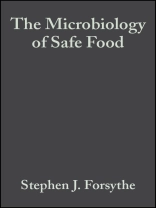The book will provide an overview of the important issues in food
safety, which shows no sign of diminishing as a topic of huge
concern from industry to consumer. The book does not set out to
compete with large standard food microbiology titles that are well
established, but will be a companion text with less scientific
background detail and more information for those actually going
into jobs where a practical knowledge of food safety issues is
necessary.
The companion website for this book can be found at:
http://www.foodmicrobe.com/info.htm
* * Practically oriented
* Author has wide experience of teaching cutting edge food safety
information
* Topic of great and growing concern
* Succinct, core, vital information for food industry
personnel
safety, which shows no sign of diminishing as a topic of huge
concern from industry to consumer. The book does not set out to
compete with large standard food microbiology titles that are well
established, but will be a companion text with less scientific
background detail and more information for those actually going
into jobs where a practical knowledge of food safety issues is
necessary.
The companion website for this book can be found at:
http://www.foodmicrobe.com/info.htm
* * Practically oriented
* Author has wide experience of teaching cutting edge food safety
information
* Topic of great and growing concern
* Succinct, core, vital information for food industry
personnel
Table of Content
Preface..1 Introduction to Safe Food.
1.1 What is Safe Food?.
1.2 The manufacture of Hygienic food.
1.3 Functional foods..
2 Basic Aspects.
2.1 The microbial world.
2.2 Bacterial cell structure.
2.3 Microbial growth cycle.
2.4 Death kinetics.
2.5 Factors affecting microbial growth.
2.6 Preservatives.
2.7 Microbial response to stress.
2.8 Predictive modelling..
3 Foodborne Illness.
3.1 The size of the food poisoning problem.
3.2 Consumer pressure effect on food processing.
3.3 Testing foods for the presence of pathogens.
3.4 Control of food poisoning.
3.5 Surveillance programmes.
3.6 Causes of food poisoning.
3.7 The microbial flora of the human gastrointestinal tract.
3.8 The mode of action of bacterial toxins.
3.9 Virulence factors of foodborne pathogens..
4 The Microbial Flora of Food.
4.1 Spoilage microorganisms.
4.2 Shelf life indicators.
4.3 Methods of prevention and shelf life extension.
4.4 Fermented foods.
4.5 Prebiotics, probiotocs and synbiotics.
4.6 Microbial biofilms..
5 Food Poisoning Microorganisms.
5.1 Indicator organisms.
5.2 Foodborne pathogens: bacteria.
5.3 Foodborne pathogens: viruses.
5.4 Seafood and shellfish poisoning.
5.5 Foodborne pathogens: eucaryotes.
5.6 Mycotoxins.
5.7 Emerging and uncommon foodborne pathogens..
6 Methods of Detection.
6.1 Prologue.
6.2 Conventional methods.
6.3 Rapid methods.
6.4 Rapid end-detection methods.
6.5 Specific detection procedures.
6.6 Accrediation schemes..
7 Food Safety Management Tools.
7.1 Microbiological safety of food in world trade.
7.2 The management of hazards in food which is in internationaltrade.
7.3 Hazard Analysis Critical Control Point (HACCP).
7.4 Outline of HACCP.
7.5 Microbiological criteria and HACCP.
7.6 Microbiological hazards and their control.
7.7 HAACP plans.
7.8 Sanitation Standard Operating Procedures (SSOPs).
7.9 Good Manufacturing Practice (GMP) and Good Hygiene Practice(GHP).
7.10 Quality Systems.
7.11 Total Quality Management (TQM).
7.12 ISO 9000 Series of standards.
8 Microbiological Criteria.
8.1 International Commission on Microbiological Specificationsfor Foods.
8.2 Codex Alimentarius principles for the establishment andapplication of microbiological criteria for foods.
8.3 Sampling plans.
8.4 Variable plans.
8.5 Attributes sampling plan.
8.6 Principles.
8.7 Microbiological limits.
8.8 Examples of sampling plans.
8.9 Implemented microbiological criteria.
8.10 Public Health (UK) Guidelines for Ready-To-Eat Foods..
9 Microbiological Assessment.
9.1 Risk assessment (RA).
9.2 Risk management.
9.3 Risk communication.
9.4 Food Safety Objectives.
9.5 Application of MRA..
10 Regulations and Authorities.
10.1 Regulations in international trade of food.
10.2 Codex Alimentarius Commission.
10.3 Sanitary and Phytosanitary measures (SPS), Technical Barriers to Trade (TBT) and the World Health Organisation(WHO).
10.4 Food authorities in the United States.
10.5 European Union legislation.
10.6 Food safety agencies.
Glossary of Terms.
Appendix: Food Safety Resources on the World Wide Web.
References.
Index.
About the author
Dr Stephen Forsythe has many years’ experience of teaching food microbiology to university students and to professionals within the food industry and government regulatory bodies. He has written an extremely useful and important book that is not only a key text for all those studying food science, technology and food microbiology but a valuable resource for government and food company regulatory personnel, quality control officers, public health inspectors, environmental health officers, food scientists, technologists and microbiologists.
Language English ● Format PDF ● Pages 424 ● ISBN 9780470999424 ● File size 2.5 MB ● Publisher John Wiley & Sons ● Published 2008 ● Downloadable 24 months ● Currency EUR ● ID 2327464 ● Copy protection Adobe DRM
Requires a DRM capable ebook reader












